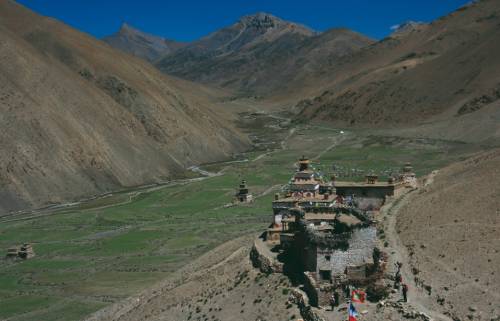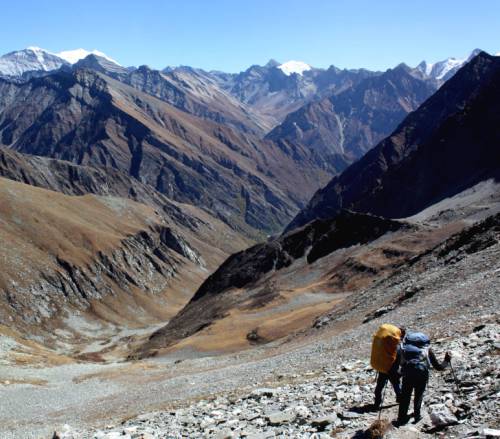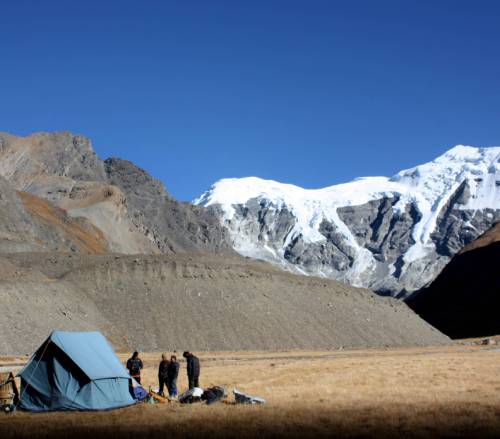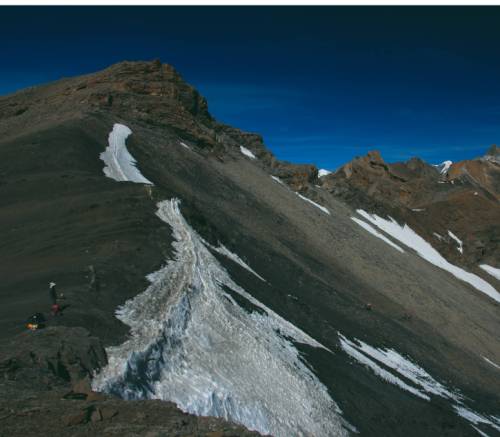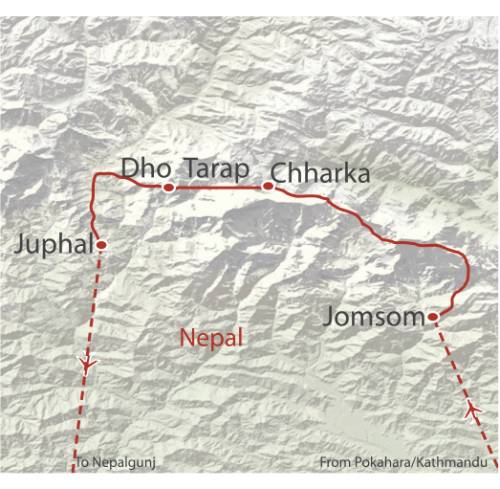GHT Upper Dolpo Traverse
GHT Upper Dolpo Traverse
$7130
Tour Overview
Embark on the GHT Upper Dolpo Traverse, an extraordinary adventure through Nepal's remote Dolpo region, part of the Great Himalaya Trail. This trek offers a unique blend of natural beauty and cultural immersion, as you traverse challenging passes like Jungben La and Niwas La, and explore the medieval village of Chharka Bhot. Experience the untouched culture of the Dolpo people, unchanged for over a millennium, and marvel at the breathtaking Phoksumdo Lake. The journey begins and ends in Kathmandu, where you'll explore its vibrant streets and World Heritage sites. Enjoy comfortable accommodations in Kathmandu and Pokhara, and fully serviced wilderness campsites during the trek. With expert guides, porters, and all necessary equipment provided, this expedition promises an unforgettable exploration of Nepal's dramatic landscapes and rich heritage. ...more ...less
Highlights
Itinerary
Day 1 : Arrive Kathmandu
Location: Kathmandu
Accommodation Name: Radisson Hotel
Meals Included: Dinner
You will be met by a representative of World Expeditions and transferred to the Radisson hotel. Remainder of the afternoon at leisure. A pre-trek briefing will be given around 4.30-5pm where arrangements will be made for the distribution of your kit bag, sleeping bag and down/fibrefill jacket. This evening we will head out for dinner, this is a great opportunity to get acquainted with your fellow group members.Overnight: Radisson Hotel ...more ...less
Day 2 : Free day in Kathmandu
Location: Kathmandu
Today you have a full day to explore Kathmandu’s bustling streets and significant landmarks. You may wish to start by exploring the city’s two most important World Heritage Listed spiritual sites: Pashupatinath, Nepal’s most sacred Hindu temple and an important cremation site; and Boudhanath, the largest Buddhist stupa in Nepal and the most sacred Tibetan Buddhist shrine outside of Tibet. Alternatively you could wander through the markets and shops of the busy Thamel precinct or explore some more of the city’s significant sites such as Swayambhunath (Monkey Temple) or the World Heritage Listed plazas of Patan, Bhaktapur or Durbar Square.
Day 3 : Fly Kathmandu to Pokhara
Location: Pokhara
Accommodation: Hotel
This morning we take a flight west to Pokhara, Nepal's second largest town. On arrival we are greeted with sights of the entire Annapurna Range.Overnight: hotel
Day 4 : Fly Pokhara to Jomsom (2760m)
Location: Jomsom
This morning we take a spectacular mountain flight to Jomsom where we will meet our trekking crew.
Day 5 - 6 : To Muktinath (3760m), walk approx. 6hrs. Rest day.
Location: Muktinath
A half day walk brings us to Muktinath, an impressive village that is our gateway to Mustang. To pass beyond this point you need a special Mustang permit. We will meet the Full GHT group today. To help with acclimatisation we will have a rest day at Muktinath.
Day 7 : To Goat Kharka (3478m), walk approx. 5-6hrs.
Location: Kagbeni
Entering the main Kali Gandaki valley we take a short cut that avoids the road to Kagbeni. Kagbeni once marked the Nepal / Tibet border and it is the official entry to the Mustang region. Within the village is the old Gompa, and at the northern edge of the village lies the remains of the old fort. We then proceed to Kharka and into the Dolpo region. From Kagbeni we head south through the village and cross a suspension bridge to a series of steep switch backs that lead to a grassy plateau. From here we follow the main trail leading to a Kharka. Dolpo People - “West of the upper Kali Gandaki, at around 4000 metres, lies the remote area of Dolpo. Surrounded by mountains over 6000m, this landscape can only be successfully inhabited by tough, hardy people. The people of Dolpo do not have a tribal name, like Sherpas, or a district name, like Lopa. There are 25 or 30 villages spread over an area of about 1300 square kilometres. The Dolpo people are very hospitable and kind, and grow most of the crops they need, as well as keeping yaks, sheep and goats for meat, wool and milk products, or to be sold or traded. Their houses are built of rough stone and all huddled together, as though trying to gain warmth and comfort from each other. This often makes the villages look like forts. Their traditional ‘fancy’ dress for women includes a striking headdress made of two rectangular brass plates with edges that turn up over the top and back of the head. These headdresses are adorned with coral and turquoise and often represent the wealth of the family. They marry by choice or arrangement, and follow Buddhism and Bon. The 1998 movie ‘Caravan’ (also called ‘Himalaya’) was shot here and told the tale of the now defunct salt caravans. You can still find locals in villages such as Saldang who appeared in the film.” - from the guide book “Nepal Trekking & The Great Himalaya Trail” by Robin Boustead.
Day 8 : To Santa (3778m), walk approx. 7-8hrs.
Location: Santa
Today is a challenging day and we must cross two passes on our way to Santa. We set out early and climb a hillside where the gradient increases as we enter a gully and pass by some caves before reaching a watercourse. We meet the main trail once again from Phalyak and make our first pass crossing at 4306m. Continuing west we contour through basins before crossig the Bhima Lojun La (4460m). Traversing for 1 -2 hours we reach a spur where we descend into a large ravine and cross a scree slope to Santa.
Day 9 : To Ghalden Ghuldun Khola (4247m), walk approx. 6hrs.
Location: Ghalden Ghuldun Khola
We follow the trail through two gullies before reaching a series of switchbacks to Jhansye (4195m). The trail now levels out as we cross a hillside and then make a descent to Kyalunpa Khola where we cross a wooden bridge and head west to a narrow gully. Our campsite set in juniper trees is gained by climbing up a steep gully.
Day 10 - 12 : To Lalinawar Khola (4800m/ 4hrs). Cross Jungben La (5550m) & Niwas La (5120m) to Nulungsunda Kharka (4987m/ 7hrs) & Chharka Bhot (4302m/ 4-5hrs).
Location: Chharka Bhot
In the coming days we make two challenging pass crossings above 5000 metres. From the top of the Jungben La we gain magnificent views to the south of Hidden Valley and Dhaulagiri can be seen. The following day we cross the Niwas La and make an easy descent to Nulungsumda Kharka where we camp at the confluence of the Malun and Thasan Kholas. The trek to Chharka Bhot is a relatively easy day.
Day 13 - 15 : To Chap Chu (4320m/ 7hrs), Maran (4350m/ 8hrs), & Tungyalaphu (4450m/ 7hrs).
Location: Dho Tarap
Heading west from Chharka Bhot we descend to the Chharka Tulsi Khola. Whilst travelling alongside the river we are forced to make a few crossings back and forth. We then make a short climb before descending to a minor tributary and crossing on stepping stones. Another climb of 45 minutes brings us to Chap Chu and our camp for the night. Our trekking day to Maran sees us crossing the Chan La (5378m), it is an easy gradient to the pass and we are now fit and acclimatised. From the top the views are stunning and we get a sense of the scale of the dramatic mountain scenery around us. From the pass we descend a series of switch backs to the valley before ascending to a ridge that sits above the Sheru Khola to our south. Once we reach a chorten we head down to the Tarpi Khola valley and on to Maran. An hour from Maran is the large trading village of Dho Tarap. Above the village is the Ribum Gompa nunnery and Regu Chorten, and time permitting we will make a visit. Today’s trek is relatively easy going to our campsite at Tungyalaphu at 4450m.
Day 16 - 18 : Cross Jyanta La (5100m) to Darsumanadobhan (4700m/ 6hrs), Saldang (3770m/ 7hrs), Shey Gompa (4345m/ 7hrs)
Location: Dolpo
We travel over the Jyanta La to a flat grassy campsite at Darsumanadobhan. The following day will find us descending to Saldang, the administrative capital of Upper Dolpo. The following day we walk to Shey Gompa via Namgung. The Shey is one of the most sacred sites in Dolpo. If we have time we may also visit the hermitage of Tsaking perched high on Crystal Mountain about an hour further north.
Day 19 - 21 : Nagdala La (5350m) /High Camp (4650m/ 6hrs), Phoksundo Khola Camp (3750m/6 hrs), Ringmo Phoksundo Lake (3620m/ 5 hrs)
Location: Phoksundo Lake
The next few days are spent on the trail to Phoksundo Lake. Leaving Shey Gompa we cross the Nagdala Pass (also known as the Kang La) and overnight at our high camp. The following day we walk to Phoksundo Khola Camp through beautiful juniper and silver birch forest. The trek to Ringmo is a stunning day and we enter pine forest before arriving at Ringmo. Phoksundo Lake is a few minutes beyond Ringmo and is undoubtedly one of the most beautiful places in the Himalaya.
Day 22 : To Chhekpa (2720m/ 5hrs)
Location: Dunai
Early in the morning, we bid farewell to the Full GHT group. As we head down south we make our way to Dunai, the administrative & trading centre of Dolpo. The landscape through which we are now travelling consists predominantly of forests, grassy meadows and plateaus. Before reaching Chhekpa we pass by the Tapriza Secondary School. The school was established by a Swiss anthology student, Marietta Kind. Visits to the school are most welcome.
Day 23 : Trek to Sulighat (2282m/ 4hrs) and drive to Jupal (2475m/ 2 hr drive)
Location: Juphal
Accommodation Name: basic hotel
Today is our final day of trekking and we pass through terraced fields on our way. Finally we reach the confluence of the Suli Khola and head down stream to cross the Thulo Beri Khola on a suspension bridge and arrive into Sulighat. From here we'll drive to Juphal in preparation for our flight tomorrow. Our accommodation tonight is in a basic hotel.
Day 24 : Fly to Kathmandu via Nepalgunj
Location: Kathmandu
Accommodation Name: Radisson Hotel
Meals Included: Breakfast
After breakfast we will return to Kathmandu. From Juphal we take a short 40 minute flight to Nepalgunj, connecting with a flight to Kathmandu of approximately 1.5 hours. On arrival transfer to the Radisson Hotel.
Day 25 : Free day in Kathmandu
Location: Kathmandu
Meals Included: Breakfast
After breakfast the day is free for you to do some final exploration of Kathmandu. In the event of weather delays to flights, this day will be used as a contingency day.
Day 26 : Trip concludes Kathmandu
Location: Kathmandu
Meals Included: Breakfast
After breakfast arrangements cease unless further ones have been made. Those people departing by aircraft will be transferred to the airport and assisted with check-in procedures.
What's Included
-
Airport transfers
Transfers are included if arriving on day 1 and 25 or if you booked pre/post tour accommodation at the Radisson through World Expeditions.
-
Flights
Flight from Kathmandu to Pokhara, Jomsom, and Nepalgunj to Kathmandu are included, valued at US$549.
-
Expert bilingual guide
An expert bilingual guide and group medical kit are provided.
What's Not Included
-
Bottled water, aerated & alcoholic drinks
These are not included in the tour package.
-
Items of a personal nature
Items such as phone calls, laundry, etc., are not included.
-
Tips
Tips are not included in the tour package.
-
International flights
International flights are not included in the tour package.
-
Airport and departure taxes
These taxes are not included in the tour package.
-
Visa
Visa costs are not included in the tour package.
-
Travel Insurance
Travel insurance is not included and must be arranged separately.
-
Insurance
Insurance is not included in the tour package.
-
International Travel
International travel is not included in the tour package.
What You Carry
In your daypack you will need to carry extra warm clothing (depending on the altitude, location and weather), a rainjacket, water bottle, camera gear, valuables and personal items such as sunscreen, lip balm etc. Porters carry all group gear and your trek pack.Grading
Mode of Transport
The tour includes flights from Kathmandu to Pokhara and Jomsom, and from Nepalgunj back to Kathmandu. Airport transfers are provided if arriving on specified days. Porters carry all personal and group equipment, ensuring a seamless trekking experience.Accommodation
Enjoy good quality accommodation in Kathmandu and Pokhara, with a stay at the Radisson Hotel in Kathmandu. During the trek, experience fully serviced wilderness campsites, providing a comfortable and immersive experience in the heart of nature.Check out our Q&As
-
What kind of cultural experiences can I expect on the GHT Upper Dolpo Traverse?
During the GHT Upper Dolpo Traverse, you will experience a culture that has remained largely unchanged for the last 1200 years. You will visit the medieval fortified village of Chharka Bhot and the nomad camps at Dho Tarap, providing a unique insight into the traditional lifestyles of the Dolpo people. ...more ...less
-
What are the main highlights of the GHT Upper Dolpo Traverse?
The main highlights of the GHT Upper Dolpo Traverse include trekking through the remote and dramatic landscapes of the Dolpo region, witnessing the stunning beauty of Phoksumdo Lake, and crossing the challenging Jungben La and Niwas La passes. You will also explore significant landmarks in Kathmandu and experience the unique culture of the Dolpo region. ...more ...less
-
What kind of accommodation is provided during the trek?
During the trek, you will stay in fully serviced wilderness campsites, which provide a comfortable and immersive experience in the heart of nature. In Kathmandu and Pokhara, good quality accommodation is provided, including a stay at the Radisson Hotel in Kathmandu.
-
What is included in the World Expeditions trek pack?
The World Expeditions trek pack includes a quality sleeping bag, a down or fibre fill jacket, and an insulated mat, which are valued at over US$500.
-
What kind of safety equipment is provided on the trek?
The trek includes safety equipment such as a satellite phone, a portable high altitude chamber, and an expedition medical kit to ensure the safety and well-being of participants.
-
What kind of meals are provided during the trek?
All meals on the trek are included, with a total of 24 breakfasts, 19 lunches, and 19 dinners provided. The meals are valued at US$1000.
-
What kind of transportation is included in the tour?
The tour includes flights from Kathmandu to Pokhara and Jomsom, and from Nepalgunj back to Kathmandu. Airport transfers are provided if arriving on specified days, and porters carry all personal and group equipment to ensure a seamless trekking experience.
-
Who will be my travelling companions on the tour?
We have offices on three continents which means your travelling companions will be just that – international and wonderfully eclectic. Part of small group travel means that although travellers come from various locations and backgrounds, you will be travelling with like-minded companions who, like you, are keen to share the experience and forge lifelong friendships.
-
What about environmental impact?
We believe that adventure travel revolves around establishing a strong relationship with the people and environments in which we operate. Our responsible travel policies have been carefully developed to ensure that we minimise the impact of our presence and help to protect the regions we visit while contributing positively to the local community.
-
What should I pack?
Your pre-departure documents include a detailed packing list with items that you need to bring. While most of the equipment for daily activities is included in your tour cost, some items like helmets and hiking boots are best brought from home. The pre-departure documents also include information on layering and recommended brands for various items to ensure you are fully prepared for your trip.
-
Do you operate a “single share” option and how does it work?
Yes. World Expeditions does not require single travellers to pay a surcharge for travelling alone on the vast majority of our trips. Our holidays are primarily on a twin share basis, so if you are joining the group as a solo traveller, we will match you with someone of your own gender. The choice is yours however; if you prefer not to share, we do offer single supplements for private occupancy.
-
Are tips included in my trip price?
Tips are not included in the tour cost. Tipping is a personal thing, do not worry about how much, or when, to tip. Tipping guidelines are provided for certain destinations in our pre departure information upon booking, however the best advice will be provided by your tour leader.
-
Am I suited to small-group travel?
We recognise that many of our travellers have not been on a ‘group trip’ before. Yet what our departures provide is both structure and flexibility, allowing you plenty of freedom within the framework of the itinerary. You’ll find that with our maximum group size at 16, you’ll travel in a minimal impact style with a great group of like-minded travellers.
-
Can you advise which vaccinations are recommended?
While our pre-departure kit provides information on vaccinations, we suggest that you consult your doctor, local government inoculation centre or a travel medical specialist in order to get the most current advice regarding vaccination requirements.
Reviews from travellers on this tour
1 Select your preferred date
Wednesday - Sunday
Jun 18, 2025 - Jul 13, 2025Book with Confidence
-
Transfer as credit for future tours
World Expeditions allows you to transfer existing payments to a future tour to avoid cancellation fees if you can't travel and inform world expeditions, 70 days before departure.
-
Low Deposit
World Expeditions requires a minimum deposit of 400 GBP per person or the full booking value, whichever is less, with the final balance not due until 70 days before departure.
-
Cancellation Policy
We don't charge a cancellation fee, here is a summary of world expeditions charges.
Up to 70 days before tour starts: Forfeit 100% of deposit.
At 69 days before tour starts: Forfeit 50% of booking price.
At 35 days before tour starts: Forfeit 100% of booking price.
GHT Upper Dolpo Traverse
26 Days Starting and ending in Kathmandu, Nepal
Visiting: Kathmandu, Pokhara, Jomsom, Muktinath, Kagbeni, Santa, Ghalden Ghuldun Khola, Chharka Bhot, Dho Tarap, Dolpo, Phoksundo Lake, Shey Phoksundo Lake, Dunai, Juphal ...more ...less
Tour operator:
Tour code:
GUD
Guide Type:
Fully Guided
Group size:
6 - 16
